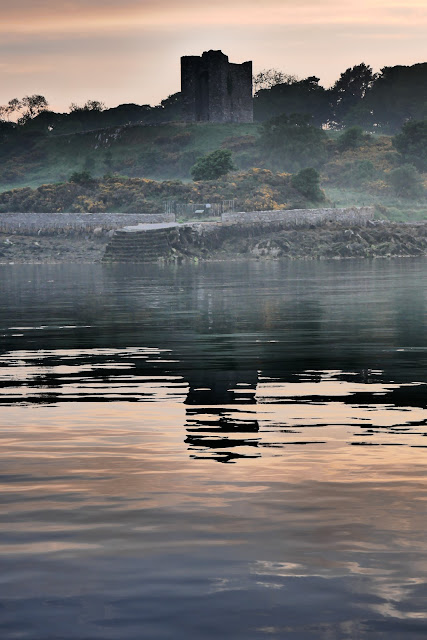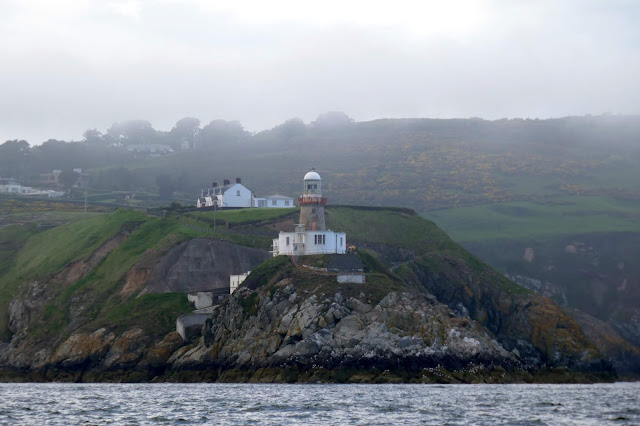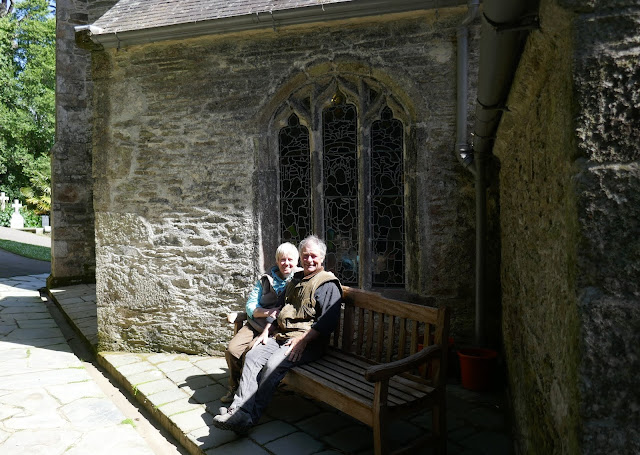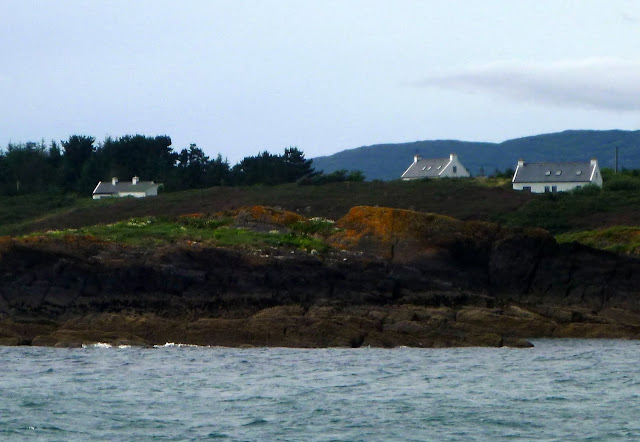 |
| Audleys Castle before the fog. |
There was the ominous hum of a big motor out there in the murky gloom as we pulled the anchor. In the thickest fog we’ve ever seen we had to leave Portaferry with an outgoing tide. The ferry was stationary, motor running, according to the AIS and there was no other traffic evident on the Radar. Taipan was whisked at 10+ knots the five miles down the channel via our incoming track and there was very little we could do about it except steer!!. Thank goodness for AIS and Radar, without which we could have been stuck there for several days.
 |
| Lions Head Light after the fog!! |
We had anchored at Audley’s Castle, Strangford Lough, en route from Islay, Scotland to Dublin. This was our second overnight stop on the Irish East Coast. The weather had been light and visibility good, until this morning. A long day followed, to arrive in Dun Laoghaire marina, just a short train ride from Dublin. The Three Festivals Tall Ships Regatta was on and we took the opportunity to visit the wharf to see the ships.
 |
| Street art collage! Dublin |
 |
| The waterfront mansions south of Dublin. Rich and famous. Enya has a house here. |
Wicklow was the next and last stop in Ireland. What a welcome. The Sailing club was open and we were invited and made very welcome. Wickow hosts the Around Ireland Race which has become a very big event attracting international yachting names. The postman was at work on the wharf touching up his ship paintings. Wicklow is set in the most beautiful countryside and we sailed on down the coast admiring its beauty. The weather looked good for a crossing direct to Landsend UK so we continued through the night to make Penzance by evening the following day.
 |
| Paintings from the history of the Wicklow Wharf with the artist / postman |
The spectacular anchorage at the foot of the magnificent St Michaels Mount and a good nights sleep before pressing on the Saint Mawes an old favorite anchorage just across the River Fal. Here the St Mawes Sailing Club once again made us very welcome and we enjoyed many evenings socializing with the club members. Especially Glen! During our visit, the Golden Globe yachts came and went and it was exciting to participate in the festivities and meet the contestants.
 |
| Tradional Work Boats racing at Saint Mawes. |
Cornish Working Boats race in St Mawes and Falmouth during the week. They're a spectacular sight with their colored topsail. These boats were preserved by an accident of history which saw the Cornwall authorities declare that endangered river Oysters could only be harvested in the River Fal using traditional Oyster boats. They must dredge under sail or oars. These boats were therefore preserved and have been elevated to racing status by aficionados. There are still working, sailing oystermen in Cornwall.
 |
| Saint Just in Roseland Church. |
 |
| Team Taipan at church |
Barry called by in his dingy to introduce himself and we caught up with him for dinner then the following day we were taken on a tour of the area. St Just in Roseland Church, a 13th century Church set amongst beautiful gardens beside a peaceful tidal creek. Legend has it that Jesus landed at the site with Joseph. The church is on the site of a 6th Century chapel which served for 400 years until it was taken over by the Bishops of Crediton and Exeter.
 |
| Fal River wildlife |
Further up the Fal is the cottage where Churchill and Eisenhower worked out the D day landings, US, and Allied troops hid in the forest along the Fal prior to the landings and there are still the remains of their huts in the area.
 |
| The famous cottage of Eisenhower and Churchills meetings |
The Fal River headwaters, where once was a thriving town. The river silted and the population moved towards the coast. The narrow meandering tidal stream provides an ideal habitat for birds, waterfowl, and wildlife. Returning to Saint Mawes we lunched at the Melinsey Mill, an old corn mill with interesting artifacts and excellent food.
 |
| Falmouth Waterfront. |
 |
| Falmouth |
Some days were spent at anchor across the river in Falmouth. This thriving regional center has loads of charm and a bustling waterfront. There are plenty of services for yachts with a huge population of boats moored, penned or hardstanding in the area.
 |
| There are all types of watercraft in Falmouth. |
David rebuilt the water maker with a new pump supplied from the UK and solenoids were tracked down to repair a faulty anchor windlass switch. We had the noisy Chartplotter fan replaced by the excellent team at Charity Taylor in Falmouth and we were at last ready to leave for France.
 |
| Saint Anthony Head farewell light. Early departure to cross the English Channel to France. |
 |
| Islay to Falmouth St Mawes |



































































